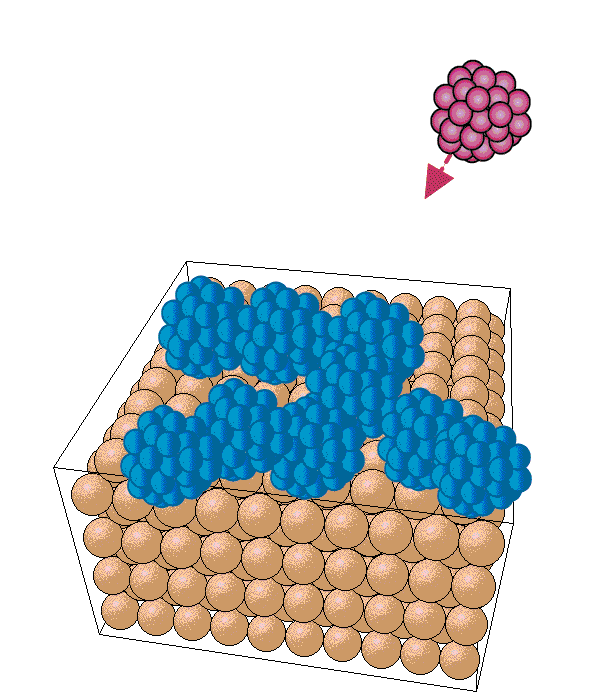Irradiation effect of Ar gas cluster ion beam
Cluster ion beam technologies have been applied in a wide range of applications. A cluster ion can transport and locally deposit a large amount of material. Energetic clusters can produce multiple collisions by constituent particles and deposit a high energy density on a solid surface. These characteristic features of cluster ions contribute to the nonlinear effects of sputtering, energy loss, damaging, and secondary ion emission, in collision with a solid surface, which is not present in collisions of mono atomic ions.
Among the cluster ion beam technologies, gas cluster ion beams (GCIB) are one of the most promising tools for nanometer scale surface modification including surface smoothing, ion implantation, and the growth of thin films. Recently, gas-cluster-ion beams have been also expected to be used as a projectile for low damage secondary ion mass spectrometry (SIMS). Since a gas cluster consists of multiple atoms that are bounded by weak intermolecular bonds, such as van der Waals bond, the fragile gas cluster ions produce many constituent particles in a collision on a solid surface. The kinetic energy of a cluster ion is distributed to each constituent particle; therefore, the particles produced on the solid surface have very low mean kinetic energy compared to mono atomic ions. The average kinetic energy of each constituent atom can be estimated by dividing the kinetic energy of a gas-cluster-ion by the number of constituent atoms, so that a gas cluster ion, which typically consists of several thousand constituent atoms or molecules, is accelerated by an electric field of several kV, each constituent particle has a mean kinetic energy of several eV. An energy range of several eV is comparable to the activation barrier for surface reactions, for example, the dissociation and adsorption or desorption of molecular or atomic species and diffusion of adatoms on a solid surface, thus such low energy particle can induce these surface reactions. It is, however, significantly lower than the energy required for sputtering, which indicates that by controlling the cluster size and impact energy, the surface reaction can be controlled without damaging the substrate surface. Therefore, size-selected gas cluster ion beams (SS-GCIB) are of great interest for practical applications in nanofabrication and also as cluster projectiles for SIMS.
Recently, it was revealed that the probability for the formation of crater-like-damage on a graphite surface, induced by collision of a huge gas-cluster-ion, is strongly dependent on the kinetic energy per constituent atom (Eatom) of the incident cluster ion. This result suggests that bond breaking and desorption processes can be controlled without sputtering of the substrate surface, by adjusting the energy per constituent atom of the cluster ion.
In this investigation, the crater-like defects formation by Ar-cluster ion has been investigated. The probability for the formation of crater-like-defects by irradiation of an argon-gas-cluster-ion beam (Ar-GCIB) onto a graphite surface can be uniformly scaled by the kinetic energy per constituent atom, regardless of various cluster sizes and acceleration voltages. The kinetic energy threshold for the formation of a crater defect on a graphite surface was found to be approximately 10 eV·atom-1. [ Furthermore, DNA molecules adsorbed on a graphite surface were preferentially sputtered by adjusting the kinetic energy of the Ar-GCIB down to this threshold, while the substrate graphite surface retained its carbon lattice structure without the formation of crater-like defects. These results indicate that GCIB could be used as a primary ion beam for secondary ion mass spectrometry (SIMS), which would enable the preferential analysis of an adsorbed layer on a substrate without causing damage to the substrate.
K. Moritani, et. al., J. Phys. Chem. C, 112, 11357-11362 (2008).
Preferential sputtering of organic molecules on a graphite surface by Ar-cluster-ion beam

